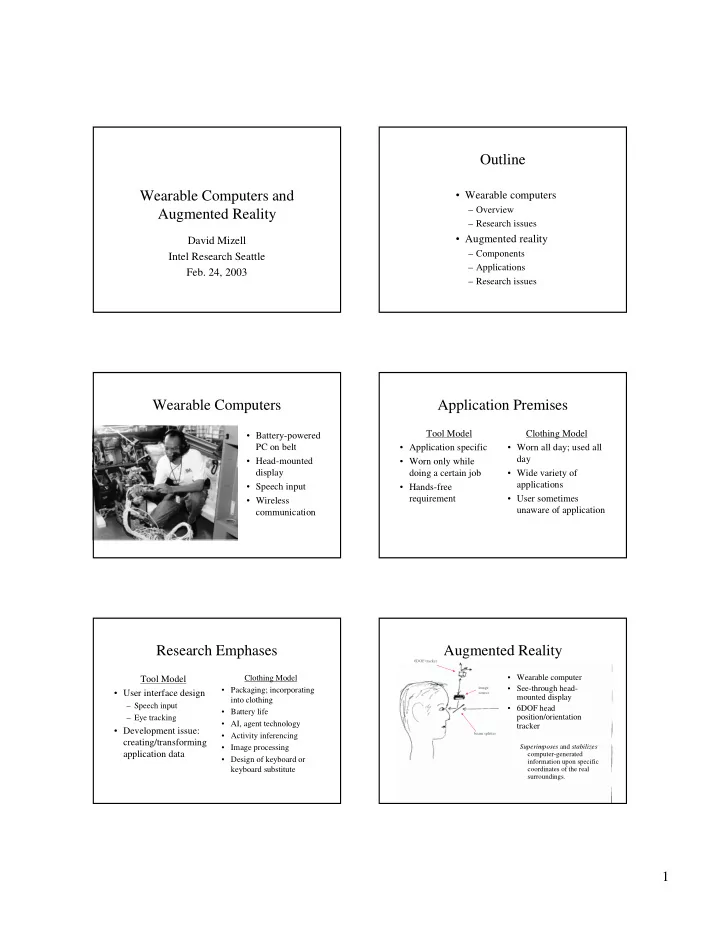

Outline Wearable Computers and • Wearable computers – Overview Augmented Reality – Research issues • Augmented reality David Mizell – Components Intel Research Seattle – Applications Feb. 24, 2003 – Research issues Wearable Computers Application Premises Tool Model Clothing Model • Battery-powered PC on belt • Application specific • Worn all day; used all day • Head-mounted • Worn only while display doing a certain job • Wide variety of applications • Speech input • Hands-free requirement • User sometimes • Wireless unaware of application communication Research Emphases Augmented Reality 6DOF tracker Clothing Model • Wearable computer Tool Model • See-through head- • Packaging; incorporating image • User interface design source mounted display into clothing – Speech input • 6DOF head • Battery life position/orientation – Eye tracking • AI, agent technology tracker • Development issue: • Activity inferencing beam splitter creating/transforming • Image processing Superimposes and stabilizes application data computer-generated • Design of keyboard or information upon specific keyboard substitute coordinates of the real surroundings. 1
An example: aircraft wire bundle Formboard storage assembly at Boeing Formboard rework The AR “generic” formboard experiment in the Boeing Everett Summary of Results factory, summer 1997 It worked. We could assemble bundles on the AR formboard, move them over to the traditional formboard, and they would pass QA inspection. •six-week experiment •wire shop & mockup shop workers •AR vs. traditional bundle forming •TriSen optical tracker & see-through HMD •Via II wearable computer (in vest) 2
AR-for-Maintenance Lab Demo Results… • Productivity was no higher. Clearly fault of the user interface. • Wide disparity of user acceptance levels. Women hated the HMD. • Intriguing anecdotal evidence of training benefits Applying Augmented Reality to Maintenance • Potential to guide minimally-trained mechanic through a complex maintenance procedure • The ultimate in “just-in-time” training -- occurs during the maintenance procedure, on the real item being maintained • Good fit for the military -- complex equipment, maintainers expensive to train, hard to keep – also for Space Station: on-orbit training for astronauts • Requires portable, easily-deployed & registered tracker system, comfortable see-through head-mounted display Also notice: AR research issues • The “minimalist” nature of the annotations. • Tracker design – At 50 Hz., track head xyz position to 1 mm., roll-pitch-yaw orientation to .1 degree – 2+ m. range (near term) – Robust – Portable – Easy to set up/calibrate – cheap 3
Trackers – what’s available now AR research issues (2) • Magnetometers – AC and DC • Authoring system – Use real object and AR • Acoustic-inertial hybrid – Use CAD model of object and VR • Optical-inertial hybrid • User interface • Videometric – What to show the user • “ultimate” tracker: track against real – How user should give input to system environment; no fiducial marking • AR display design AR display design: advantages AR display design: optical see- of optical see-through and through vs. video see-through video see-through Optical Video video camera • Higher-resolution • Work in image computer (now) domain – Pixel resolution • Lightweight – Partial occlusion • Higher frame rate • Eliminate “image (now) rivalry” Courtesy of DigiLens, Inc. Registration: the basic idea AR research issues (3) • Registration: establish fixed relationship between tracker coordinate system and real-world coordinate system, and between tracker coordinate system, display, and user’s eye • Calibration: use objects in known world V V = ( T VD T DS T SW ) V W coordinates to adjust for systematic tracking or display errors which pixel on display to point in real world world coordinates to illuminate detector to virtual dynamic – this is coordinates • (these terms often blurred together in AR research, tracker source screen of display what tracker gives coordinates – fixed at you setup time and referred to as “calibration”) Also needed: e v : coordinates of eye in virtual screen coordinates 4
Summary • Inherently multi-disciplinary research – CS – interface design – Physics – tracker design – Physiology; optics – HMD design • And you get to wear funny hats! 5
Recommend
More recommend